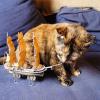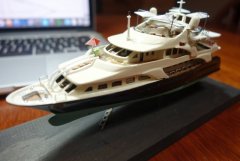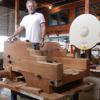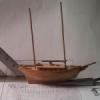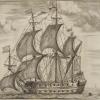Supplies of the Ship Modeler's Handbook are running out. Get your copy NOW before they are gone! Click on photo to order.
×
-
Posts
3,374 -
Joined
-
Last visited
Reputation Activity
-
 Cathead got a reaction from avsjerome2003 in Bertrand by Cathead - FINISHED - 1:87 - wooden Missouri River sternwheeler
Cathead got a reaction from avsjerome2003 in Bertrand by Cathead - FINISHED - 1:87 - wooden Missouri River sternwheeler
Progress report: the hull is planked!
As planned, I only finished the port side, leaving the bottom and starboard side open for interior views. I extended planking onto the bottom only far enough to complete the strakes necessary for the bow.
Above is the bow close-up, with the finished underside of the guards. Finish sanding hadn't happened yet in this photo.
Here's the stern. I extended the planking a short distance onto the starboard side to complete the transition, and planned the planking to follow a sweeping curve into the stern for aesthetic reasons. I think it's more attractive this way than a square cut-off at the base of the stern.
Next was priming and painting the planked portion of the hull, the nice clean white of a new steamboat. This sets off the interior bracing nicely. I also added hatch frames, cylinder timbers, and the first line of planking along the centerline.
Closeups of the bow and stern. The cylinder timbers, in pairs port and starboard, will support the actual steam engines whose pistons drive the wheel, which is supported by the aft extension of these timbers.
The next stage is complicated; it's not as simple as just planking the deck. Bertrand's superstructure is supported by timbers based in the hull, and I'd like to do this justice rather than just erecting the superstructure on the deck. Also, there are a number of hog-chains (iron rods which support the hull longitudinally) which run on braces also extending down into the hull. These, too, need to be planned for before decking is completed. Thus I may be better off constructing these items before planking, which means planking around a bunch of stuff. Should be fun to work out properly.
In the meantime, here's Missouri's own Cathy Barton and Dave Para with a nice instrumental medley:
-
 Cathead got a reaction from Omega1234 in Bertrand by Cathead - FINISHED - 1:87 - wooden Missouri River sternwheeler
Cathead got a reaction from Omega1234 in Bertrand by Cathead - FINISHED - 1:87 - wooden Missouri River sternwheeler
Hey, thanks, all. Pictures are great for lying with; this way you can't see all the little flaws that I can!
mtaylor, for what it's worth, I'm not Keith, jbelwood's comment is in a response to a question asked BY Keith about a different model, way back in comment #81.
dgbot, this is a scratchbuild, so no one "gave" me any wood. The model is entirely basswood strips from Model Shipways.
The scary part is still to come, building reasonable representations of all the internal machinery, and fitting it in amongst the complicated superstructure. But hey, we wouldn't do this if we didn't like challenges.
-
 Cathead got a reaction from mattsayers148 in Bertrand by Cathead - FINISHED - 1:87 - wooden Missouri River sternwheeler
Cathead got a reaction from mattsayers148 in Bertrand by Cathead - FINISHED - 1:87 - wooden Missouri River sternwheeler
Hey, thanks, all. Pictures are great for lying with; this way you can't see all the little flaws that I can!
mtaylor, for what it's worth, I'm not Keith, jbelwood's comment is in a response to a question asked BY Keith about a different model, way back in comment #81.
dgbot, this is a scratchbuild, so no one "gave" me any wood. The model is entirely basswood strips from Model Shipways.
The scary part is still to come, building reasonable representations of all the internal machinery, and fitting it in amongst the complicated superstructure. But hey, we wouldn't do this if we didn't like challenges.
-
 Cathead reacted to jbelwood in Bertrand by Cathead - FINISHED - 1:87 - wooden Missouri River sternwheeler
Cathead reacted to jbelwood in Bertrand by Cathead - FINISHED - 1:87 - wooden Missouri River sternwheeler
Keith,
I recently completed the Inter-Action kit of the CR Lamb stern wheeler. Go to page 8 of the gallery of completed kit built models
and take a look. You should be able to get Darryl Jacobs at Inter-Action. His eMail is "djacobs@inter-action.ca". I believe he
recently moved to Vancouver, BC. Let me know how it works out.
John Elwood
-
 Cathead reacted to mtaylor in Bertrand by Cathead - FINISHED - 1:87 - wooden Missouri River sternwheeler
Cathead reacted to mtaylor in Bertrand by Cathead - FINISHED - 1:87 - wooden Missouri River sternwheeler
Sweet work on the planking, Keith. I like the way you blended in the planking with the open areas.
-
 Cathead reacted to Jim Lad in Bertrand by Cathead - FINISHED - 1:87 - wooden Missouri River sternwheeler
Cathead reacted to Jim Lad in Bertrand by Cathead - FINISHED - 1:87 - wooden Missouri River sternwheeler
Nice work on the planking. I agree that you've done a great job in blending the planking into the unplanked areas.
John
-
 Cathead reacted to dgbot in Bertrand by Cathead - FINISHED - 1:87 - wooden Missouri River sternwheeler
Cathead reacted to dgbot in Bertrand by Cathead - FINISHED - 1:87 - wooden Missouri River sternwheeler
Nice planking job. What kind of wood did they give you to use?
David B
-
 Cathead reacted to AnobiumPunctatum in Bertrand by Cathead - FINISHED - 1:87 - wooden Missouri River sternwheeler
Cathead reacted to AnobiumPunctatum in Bertrand by Cathead - FINISHED - 1:87 - wooden Missouri River sternwheeler
Really nice planking job
-
 Cathead reacted to Mike Dowling in Bertrand by Cathead - FINISHED - 1:87 - wooden Missouri River sternwheeler
Cathead reacted to Mike Dowling in Bertrand by Cathead - FINISHED - 1:87 - wooden Missouri River sternwheeler
The standard of your workmanship continues to amaze me, it really is quite amazing. I love open models and the way you are doing this is brilliant. I shall keep watching with envy at your skill !
-
 Cathead reacted to Canute in Bertrand by Cathead - FINISHED - 1:87 - wooden Missouri River sternwheeler
Cathead reacted to Canute in Bertrand by Cathead - FINISHED - 1:87 - wooden Missouri River sternwheeler
Really like how your hull is turning out. Excellent workmanship!
-
 Cathead got a reaction from ggrieco in Bertrand by Cathead - FINISHED - 1:87 - wooden Missouri River sternwheeler
Cathead got a reaction from ggrieco in Bertrand by Cathead - FINISHED - 1:87 - wooden Missouri River sternwheeler
Progress report: the hull is planked!
As planned, I only finished the port side, leaving the bottom and starboard side open for interior views. I extended planking onto the bottom only far enough to complete the strakes necessary for the bow.
Above is the bow close-up, with the finished underside of the guards. Finish sanding hadn't happened yet in this photo.
Here's the stern. I extended the planking a short distance onto the starboard side to complete the transition, and planned the planking to follow a sweeping curve into the stern for aesthetic reasons. I think it's more attractive this way than a square cut-off at the base of the stern.
Next was priming and painting the planked portion of the hull, the nice clean white of a new steamboat. This sets off the interior bracing nicely. I also added hatch frames, cylinder timbers, and the first line of planking along the centerline.
Closeups of the bow and stern. The cylinder timbers, in pairs port and starboard, will support the actual steam engines whose pistons drive the wheel, which is supported by the aft extension of these timbers.
The next stage is complicated; it's not as simple as just planking the deck. Bertrand's superstructure is supported by timbers based in the hull, and I'd like to do this justice rather than just erecting the superstructure on the deck. Also, there are a number of hog-chains (iron rods which support the hull longitudinally) which run on braces also extending down into the hull. These, too, need to be planned for before decking is completed. Thus I may be better off constructing these items before planking, which means planking around a bunch of stuff. Should be fun to work out properly.
In the meantime, here's Missouri's own Cathy Barton and Dave Para with a nice instrumental medley:
-
 Cathead got a reaction from mattsayers148 in Bertrand by Cathead - FINISHED - 1:87 - wooden Missouri River sternwheeler
Cathead got a reaction from mattsayers148 in Bertrand by Cathead - FINISHED - 1:87 - wooden Missouri River sternwheeler
Progress report: the hull is planked!
As planned, I only finished the port side, leaving the bottom and starboard side open for interior views. I extended planking onto the bottom only far enough to complete the strakes necessary for the bow.
Above is the bow close-up, with the finished underside of the guards. Finish sanding hadn't happened yet in this photo.
Here's the stern. I extended the planking a short distance onto the starboard side to complete the transition, and planned the planking to follow a sweeping curve into the stern for aesthetic reasons. I think it's more attractive this way than a square cut-off at the base of the stern.
Next was priming and painting the planked portion of the hull, the nice clean white of a new steamboat. This sets off the interior bracing nicely. I also added hatch frames, cylinder timbers, and the first line of planking along the centerline.
Closeups of the bow and stern. The cylinder timbers, in pairs port and starboard, will support the actual steam engines whose pistons drive the wheel, which is supported by the aft extension of these timbers.
The next stage is complicated; it's not as simple as just planking the deck. Bertrand's superstructure is supported by timbers based in the hull, and I'd like to do this justice rather than just erecting the superstructure on the deck. Also, there are a number of hog-chains (iron rods which support the hull longitudinally) which run on braces also extending down into the hull. These, too, need to be planned for before decking is completed. Thus I may be better off constructing these items before planking, which means planking around a bunch of stuff. Should be fun to work out properly.
In the meantime, here's Missouri's own Cathy Barton and Dave Para with a nice instrumental medley:
-
 Cathead got a reaction from CaptainSteve in Bertrand by Cathead - FINISHED - 1:87 - wooden Missouri River sternwheeler
Cathead got a reaction from CaptainSteve in Bertrand by Cathead - FINISHED - 1:87 - wooden Missouri River sternwheeler
Progress report: the hull is planked!
As planned, I only finished the port side, leaving the bottom and starboard side open for interior views. I extended planking onto the bottom only far enough to complete the strakes necessary for the bow.
Above is the bow close-up, with the finished underside of the guards. Finish sanding hadn't happened yet in this photo.
Here's the stern. I extended the planking a short distance onto the starboard side to complete the transition, and planned the planking to follow a sweeping curve into the stern for aesthetic reasons. I think it's more attractive this way than a square cut-off at the base of the stern.
Next was priming and painting the planked portion of the hull, the nice clean white of a new steamboat. This sets off the interior bracing nicely. I also added hatch frames, cylinder timbers, and the first line of planking along the centerline.
Closeups of the bow and stern. The cylinder timbers, in pairs port and starboard, will support the actual steam engines whose pistons drive the wheel, which is supported by the aft extension of these timbers.
The next stage is complicated; it's not as simple as just planking the deck. Bertrand's superstructure is supported by timbers based in the hull, and I'd like to do this justice rather than just erecting the superstructure on the deck. Also, there are a number of hog-chains (iron rods which support the hull longitudinally) which run on braces also extending down into the hull. These, too, need to be planned for before decking is completed. Thus I may be better off constructing these items before planking, which means planking around a bunch of stuff. Should be fun to work out properly.
In the meantime, here's Missouri's own Cathy Barton and Dave Para with a nice instrumental medley:
-
 Cathead got a reaction from tadheus in Bertrand by Cathead - FINISHED - 1:87 - wooden Missouri River sternwheeler
Cathead got a reaction from tadheus in Bertrand by Cathead - FINISHED - 1:87 - wooden Missouri River sternwheeler
Progress report: the hull is planked!
As planned, I only finished the port side, leaving the bottom and starboard side open for interior views. I extended planking onto the bottom only far enough to complete the strakes necessary for the bow.
Above is the bow close-up, with the finished underside of the guards. Finish sanding hadn't happened yet in this photo.
Here's the stern. I extended the planking a short distance onto the starboard side to complete the transition, and planned the planking to follow a sweeping curve into the stern for aesthetic reasons. I think it's more attractive this way than a square cut-off at the base of the stern.
Next was priming and painting the planked portion of the hull, the nice clean white of a new steamboat. This sets off the interior bracing nicely. I also added hatch frames, cylinder timbers, and the first line of planking along the centerline.
Closeups of the bow and stern. The cylinder timbers, in pairs port and starboard, will support the actual steam engines whose pistons drive the wheel, which is supported by the aft extension of these timbers.
The next stage is complicated; it's not as simple as just planking the deck. Bertrand's superstructure is supported by timbers based in the hull, and I'd like to do this justice rather than just erecting the superstructure on the deck. Also, there are a number of hog-chains (iron rods which support the hull longitudinally) which run on braces also extending down into the hull. These, too, need to be planned for before decking is completed. Thus I may be better off constructing these items before planking, which means planking around a bunch of stuff. Should be fun to work out properly.
In the meantime, here's Missouri's own Cathy Barton and Dave Para with a nice instrumental medley:
-
 Cathead reacted to mattsayers148 in USS Ranger by mattsayers148 - FINISHED - Corel SM55 - 1:64 - 4th build, 2nd build log
Cathead reacted to mattsayers148 in USS Ranger by mattsayers148 - FINISHED - Corel SM55 - 1:64 - 4th build, 2nd build log
Thanks George, Ken and everyone for the likes.
This week entailed mounting the two 10 inch mortars. I decided to scrap the previous mortar beds and start anew.
I happened along a pdf copy of the AOTS for the bomb vessel Granado 1742. Although a bit larger than the Nutz Pirate Ship, there was a lot of really good ideas that I pumped into the noggin for a retrofitting.
I started out by making a much smaller carriage that could fit into a covered bed. I took the idea from the singular mortar bed and doubled up. Tiny rounded up some more watch parts which we made into a turntable. The octagon was then made to hold the mortars.
We followed up by making removable covers for both sides. Posts were added to the sides where a piece of iron passes through to hold the lids on in turbulent weather.
When the lids are removed, the mortars can then be elevated by portable wood supports.
The turntables should come in very handy for the Nutz and Bawlz Clans. Multiple targets can be hit, or a volley on one. It was decided that the tackle be stored rather than affixed, giving the viewer a more uninterrupted picture of the mortars.
Tiny and I are off to make some more weapons...
-
 Cathead got a reaction from cog in Bertrand by Cathead - FINISHED - 1:87 - wooden Missouri River sternwheeler
Cathead got a reaction from cog in Bertrand by Cathead - FINISHED - 1:87 - wooden Missouri River sternwheeler
Progress report: the hull is planked!
As planned, I only finished the port side, leaving the bottom and starboard side open for interior views. I extended planking onto the bottom only far enough to complete the strakes necessary for the bow.
Above is the bow close-up, with the finished underside of the guards. Finish sanding hadn't happened yet in this photo.
Here's the stern. I extended the planking a short distance onto the starboard side to complete the transition, and planned the planking to follow a sweeping curve into the stern for aesthetic reasons. I think it's more attractive this way than a square cut-off at the base of the stern.
Next was priming and painting the planked portion of the hull, the nice clean white of a new steamboat. This sets off the interior bracing nicely. I also added hatch frames, cylinder timbers, and the first line of planking along the centerline.
Closeups of the bow and stern. The cylinder timbers, in pairs port and starboard, will support the actual steam engines whose pistons drive the wheel, which is supported by the aft extension of these timbers.
The next stage is complicated; it's not as simple as just planking the deck. Bertrand's superstructure is supported by timbers based in the hull, and I'd like to do this justice rather than just erecting the superstructure on the deck. Also, there are a number of hog-chains (iron rods which support the hull longitudinally) which run on braces also extending down into the hull. These, too, need to be planned for before decking is completed. Thus I may be better off constructing these items before planking, which means planking around a bunch of stuff. Should be fun to work out properly.
In the meantime, here's Missouri's own Cathy Barton and Dave Para with a nice instrumental medley:
-
 Cathead reacted to kurtvd19 in Bertrand by Cathead - FINISHED - 1:87 - wooden Missouri River sternwheeler
Cathead reacted to kurtvd19 in Bertrand by Cathead - FINISHED - 1:87 - wooden Missouri River sternwheeler
Very nicely done planking. The way you did the stern area is very nice and much better than a straight line. An absolutely beautiful model.
Kurt
-
 Cathead got a reaction from Omega1234 in Bertrand by Cathead - FINISHED - 1:87 - wooden Missouri River sternwheeler
Cathead got a reaction from Omega1234 in Bertrand by Cathead - FINISHED - 1:87 - wooden Missouri River sternwheeler
Progress report: the hull is planked!
As planned, I only finished the port side, leaving the bottom and starboard side open for interior views. I extended planking onto the bottom only far enough to complete the strakes necessary for the bow.
Above is the bow close-up, with the finished underside of the guards. Finish sanding hadn't happened yet in this photo.
Here's the stern. I extended the planking a short distance onto the starboard side to complete the transition, and planned the planking to follow a sweeping curve into the stern for aesthetic reasons. I think it's more attractive this way than a square cut-off at the base of the stern.
Next was priming and painting the planked portion of the hull, the nice clean white of a new steamboat. This sets off the interior bracing nicely. I also added hatch frames, cylinder timbers, and the first line of planking along the centerline.
Closeups of the bow and stern. The cylinder timbers, in pairs port and starboard, will support the actual steam engines whose pistons drive the wheel, which is supported by the aft extension of these timbers.
The next stage is complicated; it's not as simple as just planking the deck. Bertrand's superstructure is supported by timbers based in the hull, and I'd like to do this justice rather than just erecting the superstructure on the deck. Also, there are a number of hog-chains (iron rods which support the hull longitudinally) which run on braces also extending down into the hull. These, too, need to be planned for before decking is completed. Thus I may be better off constructing these items before planking, which means planking around a bunch of stuff. Should be fun to work out properly.
In the meantime, here's Missouri's own Cathy Barton and Dave Para with a nice instrumental medley:
-
 Cathead got a reaction from Canute in Great Historic Maritime book read
Cathead got a reaction from Canute in Great Historic Maritime book read
I've read the book, and enjoyed it. However, as John points out, it has also been thoroughly refuted.
I look at it this way: many things are possible in history, but didn't turn out to have happened. For example, Thor Heyerdahl's Kon-Tiki voyage showed that peoples from South American plausibly COULD have sailed west in balsa rafts to colonize parts of the South Pacific. Yet modern genetic evidence refutes that otherwise quite plausible scenario.
In the same way, the Chinese fleets COULD have made the voyages, they seem to have had the technical capability of doing so. But due to various whims of history, it seems clear that they didn't. It doesn't change the entertaining nature of the book, which is compelling and interesting as a work of scholarship and conviction, as is Kon-Tiki. But a compelling argument presented in narrative form is not the same as a true one backed up by hard evidence.
-
 Cathead got a reaction from trippwj in Great Historic Maritime book read
Cathead got a reaction from trippwj in Great Historic Maritime book read
I've read the book, and enjoyed it. However, as John points out, it has also been thoroughly refuted.
I look at it this way: many things are possible in history, but didn't turn out to have happened. For example, Thor Heyerdahl's Kon-Tiki voyage showed that peoples from South American plausibly COULD have sailed west in balsa rafts to colonize parts of the South Pacific. Yet modern genetic evidence refutes that otherwise quite plausible scenario.
In the same way, the Chinese fleets COULD have made the voyages, they seem to have had the technical capability of doing so. But due to various whims of history, it seems clear that they didn't. It doesn't change the entertaining nature of the book, which is compelling and interesting as a work of scholarship and conviction, as is Kon-Tiki. But a compelling argument presented in narrative form is not the same as a true one backed up by hard evidence.
-
 Cathead got a reaction from mtaylor in Great Historic Maritime book read
Cathead got a reaction from mtaylor in Great Historic Maritime book read
I've read the book, and enjoyed it. However, as John points out, it has also been thoroughly refuted.
I look at it this way: many things are possible in history, but didn't turn out to have happened. For example, Thor Heyerdahl's Kon-Tiki voyage showed that peoples from South American plausibly COULD have sailed west in balsa rafts to colonize parts of the South Pacific. Yet modern genetic evidence refutes that otherwise quite plausible scenario.
In the same way, the Chinese fleets COULD have made the voyages, they seem to have had the technical capability of doing so. But due to various whims of history, it seems clear that they didn't. It doesn't change the entertaining nature of the book, which is compelling and interesting as a work of scholarship and conviction, as is Kon-Tiki. But a compelling argument presented in narrative form is not the same as a true one backed up by hard evidence.
-
 Cathead got a reaction from Bobstrake in Great Historic Maritime book read
Cathead got a reaction from Bobstrake in Great Historic Maritime book read
I've read the book, and enjoyed it. However, as John points out, it has also been thoroughly refuted.
I look at it this way: many things are possible in history, but didn't turn out to have happened. For example, Thor Heyerdahl's Kon-Tiki voyage showed that peoples from South American plausibly COULD have sailed west in balsa rafts to colonize parts of the South Pacific. Yet modern genetic evidence refutes that otherwise quite plausible scenario.
In the same way, the Chinese fleets COULD have made the voyages, they seem to have had the technical capability of doing so. But due to various whims of history, it seems clear that they didn't. It doesn't change the entertaining nature of the book, which is compelling and interesting as a work of scholarship and conviction, as is Kon-Tiki. But a compelling argument presented in narrative form is not the same as a true one backed up by hard evidence.
-
 Cathead got a reaction from robin b in Great Historic Maritime book read
Cathead got a reaction from robin b in Great Historic Maritime book read
I've read the book, and enjoyed it. However, as John points out, it has also been thoroughly refuted.
I look at it this way: many things are possible in history, but didn't turn out to have happened. For example, Thor Heyerdahl's Kon-Tiki voyage showed that peoples from South American plausibly COULD have sailed west in balsa rafts to colonize parts of the South Pacific. Yet modern genetic evidence refutes that otherwise quite plausible scenario.
In the same way, the Chinese fleets COULD have made the voyages, they seem to have had the technical capability of doing so. But due to various whims of history, it seems clear that they didn't. It doesn't change the entertaining nature of the book, which is compelling and interesting as a work of scholarship and conviction, as is Kon-Tiki. But a compelling argument presented in narrative form is not the same as a true one backed up by hard evidence.
-
 Cathead got a reaction from avsjerome2003 in Bertrand by Cathead - FINISHED - 1:87 - wooden Missouri River sternwheeler
Cathead got a reaction from avsjerome2003 in Bertrand by Cathead - FINISHED - 1:87 - wooden Missouri River sternwheeler
The hulls of western river boats are quite different from those of ocean-going ships, and this presents the first challenge of this project. For example, the Bertrand has no keel, meaning I will have to work out a new way to lay out the hull’s framing without an external keel to anchor everything on.
There are good reasons for this oddity. While early river boats were built like regular ships, with projecting keeps and deep hulls, it was quickly determined that this didn’t work on the shallow, fast-flowing, curvaceous rivers of the region, for several reasons:
1) Keels provide resistance against leeway. This was not only unnecessary for steam-powered boats, it was actually a detriment to the maneuverability needed to handle the sharp turns and shifting currents of the rivers. Riverboats were amazingly nimble, and large keels just got in the way.
2) Keels strengthen the hull longitudinally. This, too, quickly proved to be a detriment under western river conditions. While the long, narrow hulls of steamboats were very prone to hogging, they also needed to be flexible for the inevitable need to scrape over sandbars or even rock shoals. It has been claimed that steamboat hulls needed to flex two feet vertically to handle the river conditions they were subjected to; an overly strong keel could break the back of a steamboat like a ship on a reef, rather than allowing it to slither over shoals. We’ll explore the steamboat designers’ flexible solution to hogging later in the project.
3) Deep hulls provide stability and cargo capacity, but shallow channels made this impossible. Steamboats quickly evolved to barge-like hulls carrying all their machinery and most of their cargo on the deck; their long, flat-bottomed hulls provided all the buoyancy they needed. The Bertrand was only about 14 feet shorter than USS Constitution at the waterline, and almost as wide on deck, but with about 10% of the draft and displacement. Bertrand would have lasted mere minutes in the open sea, but Old Ironsides couldn't have made it thousands of miles upriver to western Montana carrying tons of cargo.
None of this would matter much for the model if I intended to simply plank the hull; in that case I would either cut bulkheads or shape a solid block, and just plank over everything. But I want to show off the unique internal framing of the craft, and so have to work out the best way to assemble it in place.
The Bertrand has something like 60-70 internal frames, including some cant frames in the stem. Above, you see examples of a typical midsection frame. These aren't curved the way a ship’s are, just a straight floor joined to two straight futtocks at an angle. There were multiple ways to make this joint; on the Bertrand this was a cocked-hat chine in which the two pieces were simply butted together at the turn of the bilge and braced with a triangular timber. I will need to make about 40 of these assemblies, plus 20-30 more that slowly change shape with the curve of the bow and stern.
You’ll notice that my frames are a bit thicker than the scale plans imply. This is intentional, as I feel that truly scale timbers would be extremely difficult to work with. They need to be strong enough to hold their shape against fairing and handling, and I don’t think would have enough surface area to hold glue joints properly in some of the unusual arrangements I’ll need to do. This is especially true as I intend to leave a large section unplanked, such that the frames need to hold their own. When the model is completed, I don’t think the slightly overscale timbers will be noticeable, but the model will be much stronger.
I made these by first cutting an internal wooden pattern to the exact shape of the mid-hull, as taken from the plans. The pattern is from slightly thinner stock than the frames. I then cut and lay out the three pieces, with a small dab of wood glue in the two joints, with the pattern holding them to shape. When the glue is tacky, only a few minutes, I spread more on top of the joint and lay two broader pieces at an angle across the joint to create the “cocked hat” brace (this is why the pattern needs to be thinner, so it doesn’t get glued to the brace). When the assembly is dry, I use a sharp knife to carve away the excess, including the plank-width area at the outside turn of the bilge. One broad plank will be used here between the side planking and the bottom planking, as on the prototype. While it might seem that making 40+ of these would take forever, each one takes only a few minutes. I simply make one, set it aside, and work on something else. Doing this in the background means I’ll have them all done by the time I work out the rest of the hull plan.
As for how to assemble all these, my current plan is to make a building board with parallel grooves at the spacing & depth of the hull frames. I can then set all the frames into this pattern while attaching them as on the prototype, with a variety of internal stringers and a strong keelson. This, incidentally, is another reason to use my slightly over-sized stock: it’s the same width as my table saw’s dado, making this process very convenient.
In the next installment, I’ll explore the bow area, and how I plan to tackle the framing in that area. In the meantime, I’ll be making a lot of hull frames! In the meantime, any comments, questions, and suggestions are quite welcome.
-
 Cathead got a reaction from mattsayers148 in Bertrand by Cathead - FINISHED - 1:87 - wooden Missouri River sternwheeler
Cathead got a reaction from mattsayers148 in Bertrand by Cathead - FINISHED - 1:87 - wooden Missouri River sternwheeler
Oh, no question, all along the West Coast. I've explored the wrecks of several steamers along the banks of the Yukon, where the northern climate preserves them quite well. There are some great stories about early steamers on the Columbia running the rapids and proving the river was navigable farther than originally thought. But as far as I know, all those boats followed the basic designs first developed in the Mississippi basin, which is why I find these early steamers so fascinating: they're like watching evolution in progress.
Nothing like having the sternwheel right there to bury the evidence!


